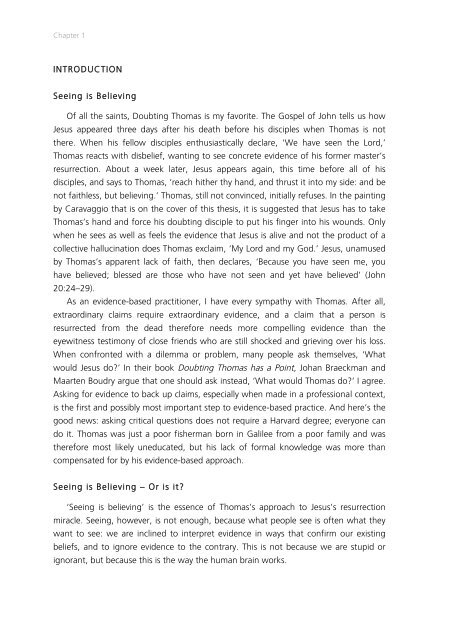In Search of Evidence
jqluvth
jqluvth
You also want an ePaper? Increase the reach of your titles
YUMPU automatically turns print PDFs into web optimized ePapers that Google loves.
Chapter 1<br />
INTRODUCTION<br />
Seeing is Believing<br />
Of all the saints, Doubting Thomas is my favorite. The Gospel <strong>of</strong> John tells us how<br />
Jesus appeared three days after his death before his disciples when Thomas is not<br />
there. When his fellow disciples enthusiastically declare, ‘We have seen the Lord,’<br />
Thomas reacts with disbelief, wanting to see concrete evidence <strong>of</strong> his former master’s<br />
resurrection. About a week later, Jesus appears again, this time before all <strong>of</strong> his<br />
disciples, and says to Thomas, ‘reach hither thy hand, and thrust it into my side: and be<br />
not faithless, but believing.’ Thomas, still not convinced, initially refuses. <strong>In</strong> the painting<br />
by Caravaggio that is on the cover <strong>of</strong> this thesis, it is suggested that Jesus has to take<br />
Thomas’s hand and force his doubting disciple to put his finger into his wounds. Only<br />
when he sees as well as feels the evidence that Jesus is alive and not the product <strong>of</strong> a<br />
collective hallucination does Thomas exclaim, ‘My Lord and my God.’ Jesus, unamused<br />
by Thomas’s apparent lack <strong>of</strong> faith, then declares, ‘Because you have seen me, you<br />
have believed; blessed are those who have not seen and yet have believed’ (John<br />
20:24—29).<br />
As an evidence-based practitioner, I have every sympathy with Thomas. After all,<br />
extraordinary claims require extraordinary evidence, and a claim that a person is<br />
resurrected from the dead therefore needs more compelling evidence than the<br />
eyewitness testimony <strong>of</strong> close friends who are still shocked and grieving over his loss.<br />
When confronted with a dilemma or problem, many people ask themselves, ‘What<br />
would Jesus do?’ <strong>In</strong> their book Doubting Thomas has a Point, Johan Braeckman and<br />
Maarten Boudry argue that one should ask instead, ‘What would Thomas do?’ I agree.<br />
Asking for evidence to back up claims, especially when made in a pr<strong>of</strong>essional context,<br />
is the first and possibly most important step to evidence-based practice. And here’s the<br />
good news: asking critical questions does not require a Harvard degree; everyone can<br />
do it. Thomas was just a poor fisherman born in Galilee from a poor family and was<br />
therefore most likely uneducated, but his lack <strong>of</strong> formal knowledge was more than<br />
compensated for by his evidence-based approach.<br />
Seeing is Believing — Or is it?<br />
‘Seeing is believing’ is the essence <strong>of</strong> Thomas’s approach to Jesus’s resurrection<br />
miracle. Seeing, however, is not enough, because what people see is <strong>of</strong>ten what they<br />
want to see: we are inclined to interpret evidence in ways that confirm our existing<br />
beliefs, and to ignore evidence to the contrary. This is not because we are stupid or<br />
ignorant, but because this is the way the human brain works.


